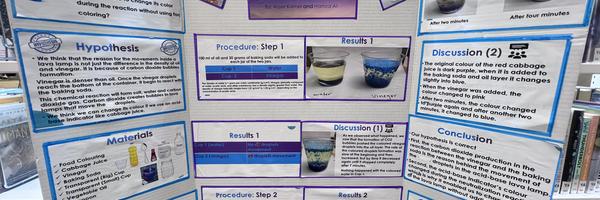Acid-Based Lava Lamp
Grade 6
Presentation
Hypothesis
-
We think that the reason for the movements inside a lava lamp is not just the difference in the density of oil and vinegar. It is because of carbon dioxide bubbles formation.
Vinegar is denser than oil. Once the vinegar droplets reach the bottom of the container, it begin to react with the baking soda.
This chemical reaction will form salt, water and carbon dioxide gas. Carbon dioxide creates bubbles in lava lamps that move the oil droplets.
-
We think we can change its colour if we use an acid-base indicator like cabbage juice.
Research
Our research started off with going through the wrong direction, as we completed the Astro Lamp's research instead of the Acid-Based one. We researched things like:
Who invented the Lava lamp (Astro Lamp)?
When was it made?
How do people use it in Modern times?
After we corrected our mistakes by focusing on the Acid-Based Lava lamp and we started research questions like:
What is the reason behind the movements inside an Acid-Based Lava lamp?
Is it possible to change its colour throughout the experiment and without using any food colouring?
As we came to a result for our first question which was the vinegar and baking soda created a neutralization reaction which interacts with oil, the oil's job is to show the results in action by releasing the vinegar droplets. For an answer for the second question we discovered that we can use red cabbage juice since it is a PH colour indicator which is something that tells whether something is acidic, basic, or neutral based on its colour.
Variables
Controlled Variables: Amount of oil, temperature, and baking soda
Independant Variables: Vinegar and water
Dependant Variables: The movements of the droplets inside a lava lamp
Procedure
-
1- Red cabbage extract was used as an acid-base indicator
-
2- The extract is added to the baking soda and the oil
-
3- The vinegar is added to them.
-
4- The colour change was observed from the beginning of the reaction until the end
Observations
Cup 1: No movements of droplets
Cup 2: Movements of droplets could be seen
Red cabbage juice was purple at first then became greenish-blue and after that became pink. When two minutes passed by the color changed to purple and then after another two minutes it changed to blue.
Analysis
As we observed what happened, we saw that the formation of CO2 bubbles pushed the coloured vinegar droplets into the oil layer. The rate of the coloured droplets formation was slow at the beginning and then increased, but by time it decreased again until it stopped completely after 5 minutes.
Nothing happened with the coloured water in Cup 1.
-
The original colour of the red cabbage juice is dark purple, when it is added to the baking soda and oil layer it changes slightly into blue.
-
When the vinegar was added, the colour changed to pink
-
After two minutes, the colour changed to purple again and after another two minutes, it changed to blue.
Conclusion
-
Our hypothesis is correct
-
First, the carbon dioxide production in the reaction between the vinegar and the baking soda is the reason behind the movement of the water droplets in the acid-base lava lamp.
-
Second, the acid-base indicator’s colour changed during the neutralization reaction which is why it enabled us to change the color of the lava lamp without adding food colouring.
Application
k
Sources Of Error
Our error was that we reffered to the wrong type of lava lamp and wrote about that one, once we figured out that, we had to change our hypothises and procedure as well as everything else.
Citations
Acknowledgement
Acknowledgments go to Creative SL channel on youtube, the American Chemical Society organization, Science Buddies, Brave the Elements, and the University of Minnesota: Acids, Bases, and Lava Lamps.

